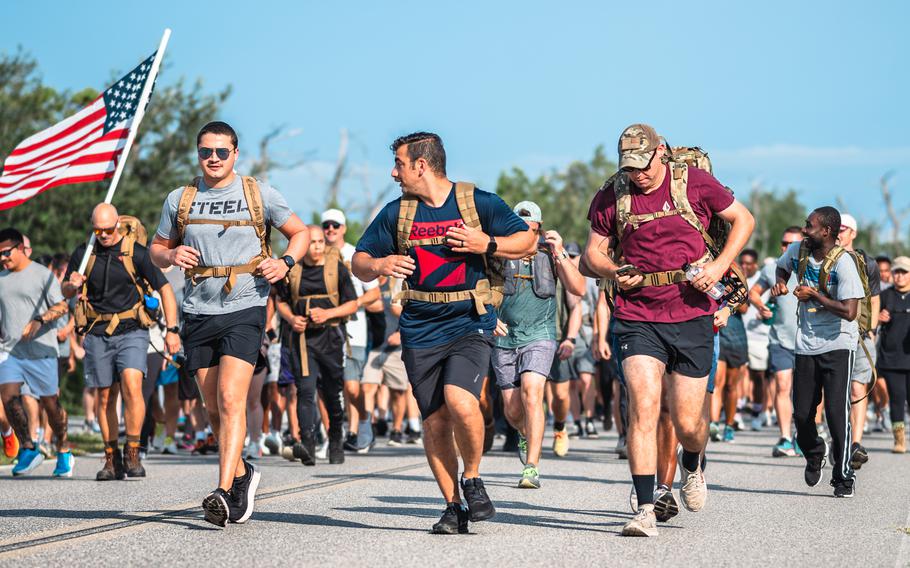
U.S. Airmen assigned to the 325th Fighter Wing participate in a ruck at Tyndall Air Force Base, Florida, June 27, 2025. The wing conducted the three-mile ruck during warrior day, a wing-wide resilience event with a primary goal to build comprehensive Airman fitness, addressing the mental, spiritual, physical and social well-being. (Zeeshan Naeem/Air Force)
The transition from military service to civilian life is challenging, one that often carries unseen burdens. A recent mental health survey conducted by the Government Accountability Office of more than 50,000 departing troops in 2023 painted a stark picture: two-thirds screened positive for a mental health condition requiring medical follow-up. Even more concerning, a federal government watchdog found that more than half of those identified in the program refused referrals to transition counseling or treatment.
These data points highlight a critical need within our veteran and military-connected community – a need that extends beyond clinical settings to embrace holistic, community-based solutions. Through my work at Team Red, White & Blue, I’ve come to believe that the connection between physical activity and mental well-being is a vital, often overlooked, piece of this puzzle.
For veterans and service members, the importance of physical fitness is ingrained. Yet many overlook that exercise is not just about maintaining combat readiness; it’s a potent, natural tool for fortifying mental health. The benefits are numerous and directly address many of the struggles veterans face.
Consider the pervasive challenges of anxiety and depression. Exercise acts as the body’s natural defense, releasing endorphins that elevate mood and combat negative thought patterns. Studies have even shown that regular physical activity can be as effective as medication for mild to moderate depression. While it’s crucial to emphasize that exercise is not a substitute for professional treatment, it serves as a complementary piece, empowering individuals to take an active role in their mental wellness journey.
A growing body of research confirms what many veterans experience firsthand: regular exercise is a powerful tool for improving mental health. A major 2023 meta-analysis published in the British Journal of Sports Medicine found that physical activity was more effective than standard care – including medication and therapy – for reducing symptoms of depression and anxiety, especially when involving moderate aerobic or strength-based exercise. Earlier studies published in Psychosomatic Medicine and The Cochrane Review echo these findings.
Beyond mood regulation, exercise significantly improves sleep quality, a foundational element of mental health often disrupted by the stresses of military service and transition. Regular physical activity helps to regulate the body’s internal clock, leading to deeper, more restorative sleep and improved mental readiness and clarity.
The cognitive benefits are equally important. Physical activity increases blood flow to the brain, sharpening cognitive function and memory. It’s akin to field training for the mind, keeping veterans alert, prepared and engaged. This enhanced brain function can be particularly beneficial in navigating the new roles and responsibilities of civilian life.
Furthermore, exercise is a remarkable stress management tool. When you engage in physical activity, your brain releases norepinephrine, a neurotransmitter that helps manage stress responses. In a world that often presents daily pressures and challenges, exercise acts as a crucial first line of defense, building resilience against the emotional toll of everyday life. This consistent physical training strengthens the emotional core, enabling individuals to bounce back from emotional challenges more quickly and effectively.
Achieving fitness goals, no matter how small, also improves self-esteem. Each workout completed, each small victory, contributes to a sense of accomplishment and self-worth, enhancing mental fortitude and confidence. This cumulative effect of achievement can be an antidote to feelings of isolation or inadequacy that can arise during transition.
One of the most vital benefits is the fostering of social connections. Group exercise provides opportunities for meaningful interaction and camaraderie. Whether it’s participating in a running group, a fitness class, or a community ruck, veterans build a robust support network – a “battle buddy” system for mental wellness. This sense of belonging, shared purpose, and mutual encouragement is key for those who may feel isolated after leaving the structured environment of the military.
Getting started doesn’t require intense workouts or superhuman feats. The key is consistency and setting achievable goals – daily walks, bodyweight exercises, or short runs. For veterans new to incorporating exercise into their mental health strategy, it’s important to find a team and a readymade challenge or plan. There are so many resources available, including Team RWB, that don’t include re-creating the wheel or going it on your own.
Whether it’s through a national organization or just setting up a regular exercise meetup with your next-door neighbor, take charge of your physical and mental well-being by connecting with fellow veterans. Your mind and body will thank you.
John “JJ” Pinter, a West Point graduate and combat veteran, is deputy director of Team Red, White & Blue. He is a former co-winner of the Dr. Wilbur B. Payne Memorial Award for Excellence in Army Analysis during his time as an Operations Research Systems Analyst for the Department of the Army. Team RWB soon will publish “Quantifying Health Gains in the Veteran Community,” a study on the impact of Team RWB’s activities on veteran health.